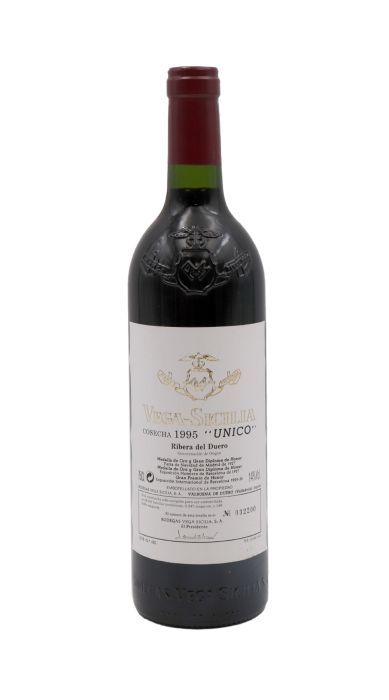Need Help Finding the right wine?
Your personal wine consultant will assist you with buying, managing your collection, investing in wine, entertaining and more.
NYC, Long Island and The Hamptons Receive Free Delivery on Orders $300+
Checkout using your account
Checkout as a new customer
Creating an account has many benefits:

1995 Vega Sicilia Unico
97 RP
Robert Parker | 97 RP
| Type of Wine |
Spain Red
: Spanish wines shouldn't be overlooked under any circumstances, as there are plenty of extraordinary wines coming from this country. There are also lots of grape varietals grown all over Spain. Some of the most gorgeous red varieties are the early-harvested Tempranillo, raspberry-flavored Garnacha, Bobal, Monastrell, as well as Cabernet Sauvignon, Syrah, and Merlot. |
|---|---|
| Varietal |
Proprietary Blend
: Proprietary Blend is a general term used to indicate that a wine is comprised of multiple grape varietals which are either “proprietary” to the winery or is blended and does not meet the required maximum or minimum percentage of a particular varietal. This also is the case for the grape’s place of origin, especially for region, appellation or vineyard designated wines. There are endless examples of blended wines which are labeled as “Proprietary Blend” and in conjunction with each region’s stipulated wine laws and regulations makes for a vast blanket for wines to fall into. Perhaps the simplest example is California; if a wine is to be labeled as Napa Valley Cabernet Sauvignon, it is required to have at least 75% of the varietal (Cabernet Sauvignon) and 85% of the fruit must be cultivated from the Napa Valley wine district. If the wine does not meet the requirements, it is then labeled as Proprietary Blend. |
| Country |
Spain
: Grapevines have been cultivated on the Iberian Peninsula for thousands of years, making Spain one of the oldest wine producing countries on earth. With nearly 1 million hectares under vine, Spain is in possession of more grapevines that any other nation in the world. Today, vineyard cultivation takes place in virtually every administrative district, making it a leading producer on today’s market. Spain’s vineyards generate an annual wine output of 40.7 million hectoliters, ranking it third in the world behind only France and Italy. Spain is a land of breathtaking beauty, diverse topography, complex cultures and a time honored tradition of viticulture. The country’s broad geographical values play a major role in defining the many wine styles produced. From the cool climes of Galicia and the snow-capped Pyrenees to arid Andalucía in the south, and every region in between the Atlantic and Mediterranean coasts, Spain boasts one of the most diverse terroirs in the world. The country’s myriad of soils and complex climate systems creates an expansive planting ground for a multitude of varietals. Tempranillo has long played an instrumental role in Spanish winemaking. It is important to note that of the 236,000 hectares being cultivated world-wide, 202,000 are planted in Spain. It is commonly utilized in the production of still red wines from Rioja, Ribera del Duero and Toro and has taken the world by storm. In the past few decades, wines produced in Rioja have been some of the most popular, and in 2017, wines with a “Rioja” label were the most purchased on the wine market. Bodegas Vega Sicilia, located in Ribera del Duero in northern Spain has been one of the most sought after producers hailing from Spain, and Tinta de Toro (otherwise known as Tempranillo everywhere else) has certainly placed its mark on the region and the world. Spain is also renowned for its production of sweet, raisened Moscatel, fortified Madeira, sparkling Cava and its rising, but shining star, Albarino, which hails from the Rias Baixas appellation of Galicia. Some of the most recognizable names in the world of wine hail from Spain. In the past few decades there has been a collision of New and Old World winemaking; one which has greatly contributed to the continued success of the Spanish wine industry. Modernization of vineyards, facilities and viticulture has greatly improved the significance of Spain in the wine market. Syrah and Merlot have taken root in Spanish wine regions and combined with the indigenous Garnacha (Grenache) Garnacha Blanca (Grenache Blanc), Godello and many others, the country has not only adapted to new styles of winemaking but also the ever changing palate of consumers. |
| Region |
Duero
: A rough environment can contribute a lot to one's character, as we're all aware. Fortunately, this also applies to wines, and there's no better example than the glorious DO of Ribera del Duero. Based almost entirely on rocky terrain, this commune is responsible for some of Spain's greatest viticultural accomplishments. Outside of Albillo-infused whites that see local popularity, this area is entirely dedicated to the production of luxurious and powerful reds. The favored varietal is Tempranillo (known over there as Tinto Fino), and the winemakers mix in a healthy dose of Cabernet Sauvignon, Merlot, and Malbec from time to time. More so than most other regions in the world, this area is known for wines that can last an astoundingly long time. This makes their reds a favorite amongst collectors and a great way for inexperienced wine enthusiasts to develop a sense of patience when it comes to wine aging. When allowed to develop sufficiently, you can expect a marvelous unraveling of smokey, intense flavors of spice and dark fruit, with leather and tobacco adding an earthy quality to them that adds a lot of raw force to the attack. |
| Subregion | Ribera del Duero |
| Producer | Vega Sicilia |
|---|
Need Help Finding the right wine?
Your personal wine consultant will assist you with buying, managing your collection, investing in wine, entertaining and more.